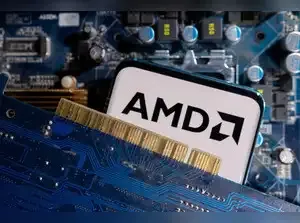AMD stock price jumps over 4% as HSBC raises target to $200—are AI chips finally putting real pressure on NVIDIA?- AMD stock price surged more than 4% on Thursday after HSBC upgraded its rating to ‘Buy’ and sharply increased its target price to $200, hinting at nearly 40% upside from current levels. This bullish revision is tied to the company’s advancing AI chip portfolio, particularly the MI300X and MI350 series, which analysts now believe can directly challenge NVIDIA's dominance in the booming AI data center space. Investors are taking notice, with big names like Meta, Microsoft, and OpenAI confirming orders for AMD’s latest GPUs.
HSBC analysts estimate the average selling price of MI355 to be around $25,000, which is $10,000 higher than their earlier forecast. Even then, it’s still roughly 30% cheaper than NVIDIA’s B200 chip, making AMD’s value proposition highly competitive. They now project AI GPU revenue to hit $151 billion by FY2026—57% higher than the current market consensus of $96 billion.
Several analysts, including those from Barclays and Jefferies, are also warming up to AMD’s prospects:
Analysts at Jefferies, Raymond James, and Loop Capital have responded by raising their AMD price targets to between $190 and $200. They see potential for AMD to capture a meaningful share of the AI GPU market, previously dominated almost entirely by NVIDIA. The MI300X’s strong price-to-performance ratio is driving this narrative shift.
Meanwhile, revenue from AMD’s Client segment fell 25% YoY, and Gaming dropped 6%, reflecting industry-wide slowdowns. However, the company held its gross margin at 52%, and expects to reach 55%+ by mid-2026, driven by high-margin AI chip sales and increased adoption of the Ryzen 9000 series.
AMD reaffirmed its $5 billion AI revenue goal by the end of 2025, even as some investors question the timeline. Still, the broader shift in sentiment suggests more are now buying into AMD's AI vision.
This could position AMD alongside other high-growth tech stocks like NVIDIA and Broadcom, which trade at even higher multiples due to their strong AI businesses.
Short-term targets:
Retail investors are piling in too. Options trading volumes on AMD jumped 38% week-over-week, with heavy call buying on $180–$200 strike prices for July and August. This suggests short-term conviction is building around a breakout toward the $200 level.
Additionally, Intel’s Gaudi 3 chips pose a future challenge if widely adopted. However, analysts say AMD’s pricing advantage, first-mover momentum, and real-world design wins make it a serious contender in AI chips—at least for the next few quarters.
The AI chip race is heating up—and AMD is no longer just a follower.
AMD stock price rose because HSBC raised its rating to ‘Buy’ and increased the target price to $200, driven by strong demand for AMD’s AI chips.
Q2: Is AMD’s MI300X chip competing with NVIDIA’s AI GPUs?
Yes, AMD’s MI300X is now seen as a real competitor to NVIDIA’s H100, with big tech firms already using it for AI workloads.
How did AMD stock perform today?
As of Friday, July 11, 2025, AMD stock is trading at $144.16, up $5.74 (+4.15%) from the previous close. This marks one of AMD’s strongest sessions in recent weeks, driven by bullish analyst sentiment and renewed AI optimism.- 52-week range: $93.12 – $211.00
- YTD performance: +27.4%
- Market cap: $233.2 billion
- Volume: 56.8 million shares (vs. 30-day avg of 44.3M)
Why is HSBC suddenly bullish on AMD stock?
HSBC had previously held a cautious view on AMD’s AI roadmap, citing modest performance improvements in earlier versions of its accelerators. However, this view changed dramatically following the company’s unveiling of the MI350 series in June at its “Advancing AI” event. Analysts now believe that the MI350—especially the MI355 accelerator—can compete with NVIDIA’s Blackwell platform, both on specs and price. HSBC upgraded AMD from 'Hold' to 'Buy' and set a new target of $200, up from its previous view that underestimated pricing power.HSBC analysts estimate the average selling price of MI355 to be around $25,000, which is $10,000 higher than their earlier forecast. Even then, it’s still roughly 30% cheaper than NVIDIA’s B200 chip, making AMD’s value proposition highly competitive. They now project AI GPU revenue to hit $151 billion by FY2026—57% higher than the current market consensus of $96 billion.
What triggered AMD's sudden surge?
On July 10, HSBC upgraded AMD from Hold to Buy and doubled its price target from $100 to $200, projecting nearly 40% upside from current levels.“AMD’s AI GPU revenue could hit $15.1 billion by FY2026, far above Wall Street's consensus of $9.6 billion,” HSBC analysts said in their note.Here’s what’s driving HSBC’s bullish thesis:
| Key Driver | Details |
| MI350 Series | Matches Nvidia’s Blackwell performance at ~30% lower cost (avg selling price ~$25,000 vs. $35,000 for Nvidia). |
| Cost Advantage | Lower total cost of ownership (TCO) could attract hyperscalers like Meta, Microsoft, and AWS. |
| Roadmap strength | AMD’s upcoming MI400/MI450 chips are expected to rival Nvidia’s next-gen Vera Rubin platform. |
| AI Ecosystem Expansion | Open software tools and ROCm platform improving fast, narrowing the CUDA advantage gap. |
What are analysts forecasting for AMD?
| Forecast Metric | Estimate |
| FY2025 Revenue (Consensus) | $28.7 billion |
| FY2025 EPS (Consensus) | $4.42 |
| FY2026 AI GPU Revenue (HSBC) | $15.1 billion |
| HSBC Price Target | $200 (40% upside) |
| Forward P/E (FY2026) | ~32x (if $6.20 EPS materializes) |
Several analysts, including those from Barclays and Jefferies, are also warming up to AMD’s prospects:
- Barclays: Maintains Overweight, target raised from $160 → $180
- Jefferies: Buy, says “AMD now firmly second in AI race”
- Goldman Sachs: Still cautious, holds Neutral with $140 target
Can AMD’s MI300X chip really challenge NVIDIA’s H100?
The real game-changer in AMD’s lineup is the MI300X, which is already being adopted by major hyperscalers. Meta Platforms has confirmed the chip will power Llama 3.1, its next-generation open-source AI model. In addition, Microsoft Azure and OpenAI are exploring deployments of AMD chips for training workloads.Analysts at Jefferies, Raymond James, and Loop Capital have responded by raising their AMD price targets to between $190 and $200. They see potential for AMD to capture a meaningful share of the AI GPU market, previously dominated almost entirely by NVIDIA. The MI300X’s strong price-to-performance ratio is driving this narrative shift.
Is Nvidia’s AI leadership in danger?
Nvidia (NASDAQ: NVDA) still dominates the AI chip market with nearly 90% market share, thanks to its:- Proprietary CUDA software stack
- Deep developer base
- Long-term enterprise relationships
- Broad product portfolio (H100, Blackwell, Vera Rubin)
| Comparison | Nvidia (Blackwell) | AMD (MI350) |
| Performance | Best-in-class | Competitive parity (per HSBC) |
| ASP (Avg Selling Price) | ~$35,000 | ~$25,000 |
| Launch Timeline | 2024 H2 | 2024 H2 |
| Ecosystem | CUDA, strong developer base | ROCm, rapidly growing |
"AMD is finally closing the AI performance gap. If it can scale supply and support, it could become a serious alternative to Nvidia," said Vivek Arya, Senior Analyst at BofA.
What do AMD's latest earnings say about its AI growth?
In Q1, AMD reported revenue of $5.47 billion, in line with expectations, with earnings per share (EPS) of $0.62, slightly ahead of Wall Street’s forecast of $0.61. The Data Center segment stood out with $2.3 billion in revenue, up 80% year-over-year, thanks to strong uptake of the MI300 line.Meanwhile, revenue from AMD’s Client segment fell 25% YoY, and Gaming dropped 6%, reflecting industry-wide slowdowns. However, the company held its gross margin at 52%, and expects to reach 55%+ by mid-2026, driven by high-margin AI chip sales and increased adoption of the Ryzen 9000 series.
AMD reaffirmed its $5 billion AI revenue goal by the end of 2025, even as some investors question the timeline. Still, the broader shift in sentiment suggests more are now buying into AMD's AI vision.
What are analysts saying about AMD's future valuation?
Despite trading at a forward P/E of 52x on expected 2025 earnings, analysts argue AMD’s valuation is justified—perhaps even conservative—given its rapidly expanding AI opportunity. If AMD achieves $4B–$5B in AI-related sales by 2025, with an estimated 25–30% operating margin, it could bring in $1.2B–$1.5B in incremental income, boosting overall earnings by up to 25%.This could position AMD alongside other high-growth tech stocks like NVIDIA and Broadcom, which trade at even higher multiples due to their strong AI businesses.
Short-term targets:
- $150–$160 range could be tested in coming weeks if technical momentum holds.
- Support: ~$135
- Resistance: $151.40 (April high)
- If AMD executes its MI400 launch in 2025, and AI GPU sales hit $15B+ in FY26, a $200+ valuation is reasonable.
- Catalysts to watch: Q2 earnings (expected August 5), hyperscaler adoption updates, MI450 development news.
Are institutions and traders betting big on AMD stock?
Yes, and the momentum is growing. In Q2 2025 filings, institutional investors like Vanguard and BlackRock increased their AMD positions, while hedge funds such as Coatue Management and D1 Capital opened new stakes. Notably, AMD insiders have not sold stock since April, a sign of internal confidence.Retail investors are piling in too. Options trading volumes on AMD jumped 38% week-over-week, with heavy call buying on $180–$200 strike prices for July and August. This suggests short-term conviction is building around a breakout toward the $200 level.
What are the risks to AMD’s $200 stock target?
Despite the strong setup, AMD isn’t without risks. NVIDIA’s lead in CUDA software and ecosystem loyalty still gives it a competitive edge. AMD must grow its ROCm software and ecosystem fast to win over more developers and customers. TSMC’s production constraints may also limit output, especially with rising HBM3e demand.Additionally, Intel’s Gaudi 3 chips pose a future challenge if widely adopted. However, analysts say AMD’s pricing advantage, first-mover momentum, and real-world design wins make it a serious contender in AI chips—at least for the next few quarters.
Is AMD stock a buy at current levels?
With real traction from Meta, Microsoft, and OpenAI, rising gross margins, and a sharply upgraded AI revenue forecast, AMD stock (NASDAQ:AMD) is seeing a clear re-rating from Wall Street. If delivery timelines hold and adoption continues, the stock could realistically hit $195–$200 in Q3.The AI chip race is heating up—and AMD is no longer just a follower.
FAQs:
Q1: Why did AMD stock price rise after HSBC’s rating upgrade?AMD stock price rose because HSBC raised its rating to ‘Buy’ and increased the target price to $200, driven by strong demand for AMD’s AI chips.
Q2: Is AMD’s MI300X chip competing with NVIDIA’s AI GPUs?
Yes, AMD’s MI300X is now seen as a real competitor to NVIDIA’s H100, with big tech firms already using it for AI workloads.








